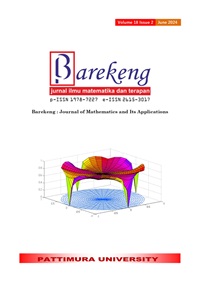APPLICATION OF K-MEANS AND FUZZY C-MEANS ALGORITHMS TO DETERMINE FLOOD VULNERABILITY CLUSTERS (CASE STUDY: KUTAI KARTANEGARA REGENCY)
Abstract
Flooding show situation where areas that are not usually inundated, such as farmland and settlements, and city district areas, become inundated due to water. Floods can to occur when the flow of water on rivers or waste channels overrun its normal measurements. This study describes the K-Means and Fuzzy C-Means Algorithm methods for clustered flood-prone areas built on Districts in Kutai Kartanegara Regency. This research begins with data collection in the character of rainfall, land elevation, the number of victims affected, the quantity of damaged houses, the quantity of damage to facilities and the quantity of flood events. Before the data is processed using these two methods, data normalization will be carried out in a dataset which aims to shape the data into positional values from the same range. K-Means and Fuzzy C-Means are accustomed to identifying groups in each sub-district in Kutai Kartanegara Regency that have a level of vulnerability to floods. At this stage, 3 initial clusters were carried out, namely high, medium, and low vulnerability clusters. The validity test produces a Silhouette Index value of 0.574283589 and a Partition Coefficient Index of 0.78905. The outcome of the K-Means method with the standard deviation within and between clusters are 0.5131 and the Fuzzy C-Means method for the standard deviations within and between clusters is 0.3489. based uppon value of the silhouette index, partition coefficient index and standard deviation within and between clusters it results that Fuzzy C-Means is the best method of this study.
Downloads
References
P. Kukar, "Bupati Kukar Datangi Titik Banjir Kembang Janggut, Ketersediaan Sembako Dipastikan Aman," 2019. [Online].
H. Rahmah, "Kabupaten Kutai Kartanegara Dalam Angka 2023," Balikpapan, 2023.
D. R. a. W. D. U. R. L. Rohmah, "LOMBA DAN SEMINAR MATEMATIKA XXVIII Zonasi Daerah Terdampak Bencana Angin Puting Beliung Menggunakan K-Means Clustering," 2020. [Online]. Available: http://dibi.bnpb.go.id.
E. Oktaviana, CLUSTERING BENCANA ALAM DI INDONESIA MENGGUNAKAN ALGORITMA K-MEANS, Surabaya, 2022.
T. S. Madhulatha, "An Overview on Clustering Methods," IQSR, vol. 2, no. 4, pp. 719 - 725, 2012.
A. E. Z. Ramadhan, "Perbandingan K-Means dan Fuzzy C-Means untuk Pengelompokan Data User Knowledge Modeling," SNTKI, pp. 219 - 226, 2017.
B. M. N. P. V. Bangoria, "A Survey on Efficient Enhanced K-Means Clustering Algorithm," International Journal for Scientific Research and Development, vol. I, no. 9, 2013.
C. L. K. N. I. B. Simbolon, "Clustering lulusan mahasiswa matematika FMIPA Untan Pontianak menggunakan Algoritma Fuzzy C-Means," Buletin Ilmiah Mat, Stat, dan Terapannya (Bimaster), vol. 02, no. 1, pp. 21 - 26, 2013.
A. L. N. B. S. M. A. Hana Sugiastuti F., "PERBANDINGAN METODE FUZZY C-MEANS DAN K-MEANS UNTUK PEMETAAN DAERAH RAWAN KRIMINALITAS DI KOTA SEMARANG," Elipsoida: Jurnal Geodesi dan Geomatika, vol. 4, no. 1, pp. 58 - 64, 2021.
T. T. H. a. S. Al-Faraby, "Analisis Churn Prediction pada Data Pelanggan PT. Telekomunikasi dengan Logistic Regression dan Underbagging,”," 2017.
P. P. H. K. K. K. a. D. M. Ahmad Harmain, "NORMALISASI DATA UNTUK EFISIENSI K-MEANS PADA PENGELOMPOKAN WILAYAH BERPOTENSI KEBAKARAN HUTAN DAN LAHAN BERDASARKAN SEBARAN TITIK PANAS," TEKNIMEDIA: Teknologi Informasi dan Multimedia, vol. 2, no. 2, pp. 83 - 89, 2022.
D. A. P. D. J. d. I. T. Remawati, "Metode K-Means Untuk Pemetaan Persebaran Usaha Mikro Kecil Dan Menengah," Jurnal Teknologi Informasi dan Komunikasi (TIKomSiN), vol. 9, no. 2, pp. 39 - 46, 2021.
M. H. a. P. R. A. Struyf, "Clustering in an Object-Oriented Environment," Stat Softw, vol. 1, no. 4, 1996.
R. L. Rohmah, "Zonasi Daerah Terdampak Bencana Angin Puting Beliung Menggunakan K-Means Clustering dengan Analisis Silhouette 65 Coefficient, Davies Bouldin Index dan Purity," Universitas Islam Negeri Sunan Ampel, 2019.
V. Y. I. I. a. M. H. H. D. L. Rahakbauw, "IMPLEMENTASI FUZZY C-MEANS CLUSTERING DALAM PENENTUAN BEASISWA," BAREKENG: Jurnal Ilmu Matematika dan Terapan, vol. 11, no. 1, pp. 1 - 12, 2017.
H. I. K. H. Saadaki Miyamoto., Algorithms for Fuzzy Clustering, Osaka, 2008.
K.-L. Wu, "Analysis of parameter selections for fuzzy c-means," Pattern Recognit, vol. 45, no. 1, pp. 407 - 415, 2012.
J. R. M. J. a. A. T. D. M. J. Bunkers, "Definition of Climate Regions in the Northern Plains Using an Objective Cluster Modification Technique," J Clim, vol. 9, no. 1, pp. 130 - 146, 1996.
Copyright (c) 2024 Desi Nurjanah, Indira Anggriani, Primadina Hasanah

This work is licensed under a Creative Commons Attribution-ShareAlike 4.0 International License.
Authors who publish with this Journal agree to the following terms:
- Author retain copyright and grant the journal right of first publication with the work simultaneously licensed under a creative commons attribution license that allow others to share the work within an acknowledgement of the work’s authorship and initial publication of this journal.
- Authors are able to enter into separate, additional contractual arrangement for the non-exclusive distribution of the journal’s published version of the work (e.g. acknowledgement of its initial publication in this journal).
- Authors are permitted and encouraged to post their work online (e.g. in institutional repositories or on their websites) prior to and during the submission process, as it can lead to productive exchanges, as well as earlier and greater citation of published works.






1.gif)



